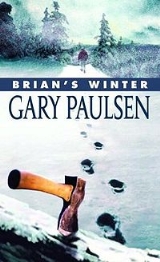
Brian's Winter
Encyclopedia
Brian's Winter is a 1996
young adult novel by Gary Paulsen
. It is the third novel in the Hatchet series, but second in terms of chronology as an alternate ending
sequel to Hatchet
.
It was also released as Hatchet: Winter by Pan Macmillan on February 9, 1996.
wilderness after a plane accident, decides to dive for supplies from the submerged aircraft. He almost drowns. He recovers, among other things, an emergency transmitter. Within hours, a pilot receives the beacon and rescues him. The book ends with a note that Brian, who learns wilderness survival
through trial and error, probably would not have survived the upcoming harsh winter.
Paulsen says that many readers wrote to him, complaining about the deus ex machina
ending. In response, Paulsen wrote Brian's Winter, which explores what would have happened if Brian had not activated the transmitter.
, and learning how to make a bow more powerful. Eventually, Brian meets a family of Cree
trappers, the Smallhorns, who help him return home. Brian also learned that he should "always pay attention to what's happening around him."
and Brian's Hunt
as they recognize the book as a series canon. The River does not and includes no mention that the events of Brian's Winter ever took place as Brian tells Derek Holtzer that he only spent fifty-four days in the wilderness. This is due to the fact that The River was published in 1991, five years before the release of Brian's Winter.
1996 in literature
The year 1996 in literature involved some significant events and new books.-Events:*Harper Lee's novel, To Kill a Mockingbird, is removed from an advanced placement English reading list in Lindale, Texas because it "conflicted with the values of the community."* In the United Kingdom, the first...
young adult novel by Gary Paulsen
Gary Paulsen
Gary James Paulsen is an American writer who writes many young adult coming of age stories about the wilderness. He is the author of more than 200 books , 200 magazine articles and short stories, and several plays, all primarily for young adults and teens.-Biography:Gary Paulsen was born in...
. It is the third novel in the Hatchet series, but second in terms of chronology as an alternate ending
Alternate ending
Alternate ending is a term used to describe the ending of a story that was planned or debated but ultimately unused in favor of the actual ending. Generally, alternate endings are considered to have no bearing on the canonical narrative...
sequel to Hatchet
Hatchet (novel)
Hatchet is a 1987 three-time Newbery Honor-winning wilderness survival novel written by Gary Paulsen. It is the first novel in the Hatchet series and is followed by four sequels....
.
It was also released as Hatchet: Winter by Pan Macmillan on February 9, 1996.
Background
At the end of Hatchet, thirteen-year-old Brian Robeson, who has been trapped in the CanadianCanada
Canada is a North American country consisting of ten provinces and three territories. Located in the northern part of the continent, it extends from the Atlantic Ocean in the east to the Pacific Ocean in the west, and northward into the Arctic Ocean...
wilderness after a plane accident, decides to dive for supplies from the submerged aircraft. He almost drowns. He recovers, among other things, an emergency transmitter. Within hours, a pilot receives the beacon and rescues him. The book ends with a note that Brian, who learns wilderness survival
Survival skills
Survival skills are techniques a person may use in a dangerous situation to save themselves or others...
through trial and error, probably would not have survived the upcoming harsh winter.
Paulsen says that many readers wrote to him, complaining about the deus ex machina
Deus ex machina
A deus ex machina is a plot device whereby a seemingly inextricable problem is suddenly and abruptly solved with the contrived and unexpected intervention of some new event, character, ability, or object.-Linguistic considerations:...
ending. In response, Paulsen wrote Brian's Winter, which explores what would have happened if Brian had not activated the transmitter.
Plot summary
The story deals with Brian, still stranded at the L-shaped lake during the fall and winter, constructing a winter shelter, building snow shoes, being attacked by a bearBear
Bears are mammals of the family Ursidae. Bears are classified as caniforms, or doglike carnivorans, with the pinnipeds being their closest living relatives. Although there are only eight living species of bear, they are widespread, appearing in a wide variety of habitats throughout the Northern...
, and learning how to make a bow more powerful. Eventually, Brian meets a family of Cree
Cree
The Cree are one of the largest groups of First Nations / Native Americans in North America, with 200,000 members living in Canada. In Canada, the major proportion of Cree live north and west of Lake Superior, in Ontario, Manitoba, Saskatchewan, Alberta and the Northwest Territories, although...
trappers, the Smallhorns, who help him return home. Brian also learned that he should "always pay attention to what's happening around him."
Continuity with series
Brian's Winter is followed chronologically by the two sequels, Brian's ReturnBrian's Return
Brian's Return is a 1999 wilderness survival novel written by Gary Paulsen and fourth novel in the Hatchet series.It was also released as Hatchet: The Call by Macmillan Children's Books in the UK on January 8, 1999.-Plot:...
and Brian's Hunt
Brian's Hunt
Brian's Hunt is a 2003 young adult novel by Gary Paulsen. It is the fifth and final book in the award-winning Hatchet series, which deals with Brian Robeson, a boy who learns wilderness survival when he is stranded after a plane wreck....
as they recognize the book as a series canon. The River does not and includes no mention that the events of Brian's Winter ever took place as Brian tells Derek Holtzer that he only spent fifty-four days in the wilderness. This is due to the fact that The River was published in 1991, five years before the release of Brian's Winter.

